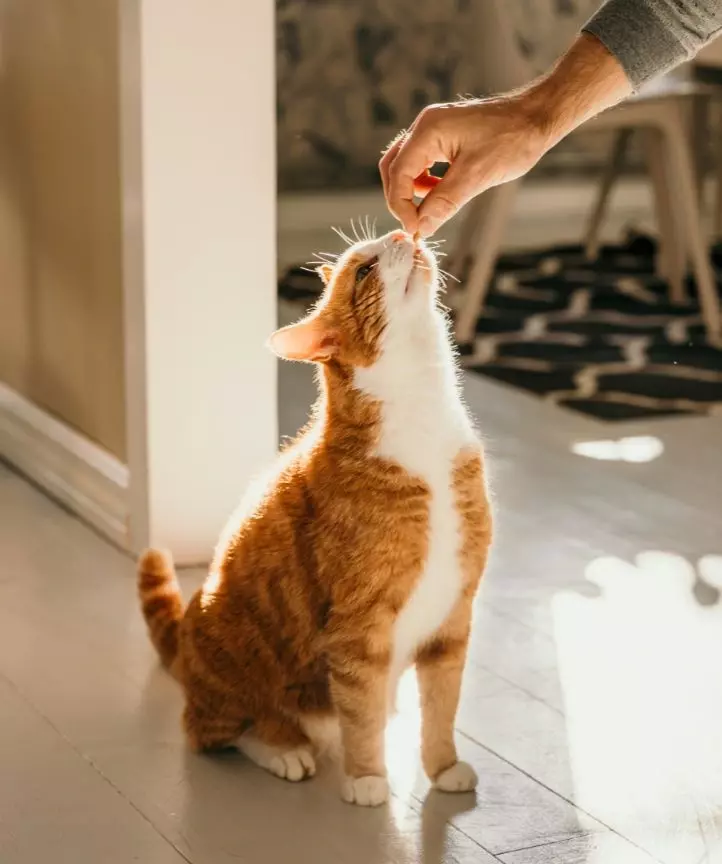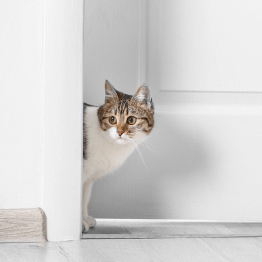HOW TO INTRODUCE CATS TO EACH OTHER
By: Door Buddy Editors | Published: 30 October 2024

Bringing a new cat home? Thinking of introducing your cats to each other? Whether you’ve got a bold explorer or a shy sweetheart, introducing felines can be a bit like matchmaking - there’s a fine balance! But don’t worry; we’ve got you covered with some “pawsome” tips on how to introduce cats to each other so that they can become friends. If you’re still figuring out the perfect feline addition, check out our blog, “What Type of Cat is Best for Me,” for help choosing the right match!
Step 1: Set Up A Cozy Safe Space For Your New Cat
Before diving into cat introductions, it’s crucial to ensure your new kitty feels comfortable in their new home. Set up a cozy space just for them, complete with essentials like food, water, cat bed, cat toys, and their litter box. Creating a safe and personal area will help them adjust smoothly. Since cats aren’t fans of closed doors, Door Buddy is a great solution - it keeps doors slightly open so your cat can move freely while keeping other pets or children out.
When you’re deciding how to introduce a new cat to a new home, think of it like giving them a grand tour! Let them explore their surroundings at their own pace before meeting their future feline friend.
Step 2: Separate the Cats and Start a Scent Swap
After a few days, you can start the fun by letting your cats get a whiff of each other’s scent and hear those adorable little sounds through a closed door! This way, both cats can get used to each other’s presence in a relaxed, stress-free way - think of it as a little “meet and greet” party, but with a door in between for safety!
Now that they’re sensing each other, try a scent swap to keep things moving forward. Exchange their bedding or toys so they can take in each other’s fabulous feline essence. This gentle introduction allows them to sniff out their future friend without any face-to-face drama, making the process calm and friendly for both cats.

Step 3: Let Them See Each Other With A Barrier
After a few days of keeping your cats separated, it’s time for the fun part: letting them see each other! A great way to do this is by using a baby gate or your Door Buddy - adjust it to its narrowest setting to allow visual contact without letting either cat squeeze through. This setup allows them to catch glimpses of one another while still feeling secure in their own space. During these supervised “peeking” sessions, you can sit nearby to monitor their reactions. It’s an exciting time for both cats, as they can explore each other’s presence without the risk of a surprise ambush or confrontation.
Look for positive interactions, like curious sniffing or playful paw swipes. If either cat seems stressed or agitated, don’t rush the process - take a step back and give them more time apart before trying again. This gradual introduction allows them to adjust at their own pace, building confidence and reducing anxiety as they get ready for their first face-to-face meeting!
Step 4: Gradual Face-to-Face time
When the time feels right, and your cats have had a chance to get used to each other’s scents and sounds, it’s time for the big moment: removing the barrier! Start by choosing a neutral space where both cats can feel safe and comfortable. Keep the atmosphere light and fun - maybe even have some tasty treats on hand to reward them for being brave. Allow them to see each other for the first time while keeping the introductions slow and supervised.
Watch their body language; look for signs of curiosity or playfulness rather than aggression. If things go smoothly, you can let them explore their new relationship at their own pace, fostering a friendship that will hopefully blossom into a delightful companionship!

Step 5: Extend Interaction Time
As the cats become more comfortable with each other, you can gradually increase the length of their interactions to help build trust and familiarity. Always supervise them closely to ensure that neither cat feels threatened. Reward calm and friendly behavior with treats or praise to reinforce positive interactions.
If you notice signs of stress - like hissing, growling, or attempts to hide - separate them immediately and give each kitty time to relax. Patience is key, as each cat will socialize at its own pace. By taking it slow and respecting their boundaries, you can foster a positive environment for a lasting friendship between your feline companions.
Step 6: Monitor Progress and Be Patient
Every cat is different, so the timeline can vary. Some cats might adjust in days, while others may need weeks or even months to settle. Stay patient and flexible, watching their cues and celebrating small wins.
By going step by step, you’ll help your cats feel safe, gradually building their trust and giving them the best chance at becoming lifelong friends.
FREQUENTLY ASKED QUESTIONS ABOUT INTRODUCING CATS TO EACH OTHER
Wondering how long it takes for cats to get used to each other? The truth is, it’s different for every kitty. Some will hit it off within a few days, while others may need weeks - or even months! Patience is key, so let them set their own pace.
If you’re dealing with girl cats, you might be wondering how to introduce female cats to each other. Female felines can be a little more territorial, so take it extra slow. Give both girls plenty of space and time to adjust, and remember to treat them to special one-on-one time with you to prevent jealousy.
If your cats have settled indoors, you might want to introduce cats to the outdoors safely. Make sure your cat feels fully comfortable at home first - then ease them into the outdoor world with short, supervised trips. Harnesses can be a great way to let your cat explore safely and confidently.
What’s the dream scenario when you’re introducing your cats? Look for good signs when introducing cats, such as:
-
Curious sniffing: If they’re interested in checking each other out, that’s a great start!
-
Relaxed tails: Calm and neutral body language is always a win.
-
Playfulness: Light chasing or playful batting without aggression means they’re warming up to each other.
-
Slow blinking: If your cats are giving each other the slow blink, it’s a cat version of a trust handshake.
Not all interactions are going to be smooth, and that’s okay! Just keep an eye out for warning signs when introducing cats, like:
-
Hissing or growling: This usually means they’re feeling unsure or threatened.
-
Pinned-back ears: If the ears are flat, your cat might be feeling defensive.
-
Swatting: If the claws come out, take a step back and give them more time apart.
If you notice any of these behaviors, don’t fret! Simply return to the earlier stages of the introduction and proceed at a slower pace. For a deeper understanding of cat body language, be sure to check out this blog.
Introducing a cat to a dog can come with its challenges, but it’s important to take it slow to ensure everyone feels comfy! Start by letting them get acquainted with each other’s scent - try swapping their bedding or giving each pet a sniff of the other’s favorite toy. When it’s time for their big meet-and-greet, keep the dog on a leash and let the cat explore at its own pace. You can even turn it into a game by using treats and praise to reward them for being calm and friendly. Just keep an eye on their interactions, and don’t rush things! For more tips on making this introduction a breeze, check out our blog on How To Introduce a Cat to a Dog.
CONCLUSION: HOW TO INTRODUCE CATS TO EACH OTHER
Introducing cats to each other may require patience, but the payoff is totally worth it! Whether you’re bringing a new furball home, getting your cats used to the outdoors together, or helping your female cats bond, keeping the experience fun and positive will create a safe, confident space for everyone.
Watch for those encouraging signs, stay calm, and soon enough, you’ll have a cozy pair of “purr-fectly” content companions curled up side by side.




